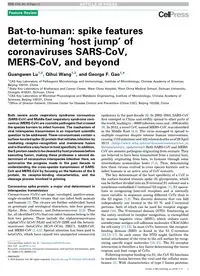
2015 Bat-to-human_ spike features determining _host jump_ of coronaviruses SARS-CoV, MERS-CoV, and beyond PDF
Preview 2015 Bat-to-human_ spike features determining _host jump_ of coronaviruses SARS-CoV, MERS-CoV, and beyond
Bat-to-human: spike features determining ‘host jump’ of coronaviruses SARS-CoV, MERS-CoV, and beyond Guangwen Lu1,2, Qihui Wang1,3, and George F. Gao1,4 1 CAS Key Laboratory of Pathogenic Microbiology and Immunology, Institute of Microbiology, Chinese Academy of Sciences, Beijing 100101, China 2 State Key Laboratory of Biotherapy and Cancer Center, West China Hospital, West China Medical School, Sichuan University, Chengdu 610041, Sichuan, China 3 CAS Key Laboratory of Microbial Physiological and Metabolic Engineering, Institute of Microbiology, Chinese Academy of Sciences, Beijing 100101, China 4 Office of Director-General, Chinese Center for Disease Control and Prevention (China CDC), Beijing 102206, China Both severe acute respiratory syndrome coronavirus (SARS-CoV) and Middle East respiratory syndrome coro- navirus (MERS-CoV) are zoonotic pathogens that crossed the species barriers to infect humans. The mechanism of viral interspecies transmission is an important scientific question to be addressed. These coronaviruses contain a surface-located spike (S) protein that initiates infection by mediating receptor-recognition and membrane fusion and is therefore a key factor in host specificity. In addition, the S protein needs to be cleaved by host proteases before executing fusion, making these proteases a second de- terminant of coronavirus interspecies infection. Here, we summarize the progress made in the past decade in understanding the cross-species transmission of SARS- CoV and MERS-CoV by focusing on the features of the S protein, its receptor-binding characteristics, and the cleavage process involved in priming. Coronavirus spike protein: a major viral determinant in interspecies transmission Coronaviruses (CoVs) are large, enveloped, positive-sense, single-stranded RNA viruses that can infect both animals and humans [1]. The viruses are further subdivided, based on genotypic and serological characters, into four genera: Alpha-, Beta-, Gamma-, and Deltacoronavirus [2,3]. Thus far, all identified CoVs that can infect humans belong to the first two genera. These include the alphacoronaviruses (alphaCoVs) hCoV-NL63 and hCoV-229E and the betacor- onaviruses (betaCoVs) HCoV-OC43, HKU1, SARS-CoV, and MERS-CoV [1,4,5]. Special attention has been paid to betaCoVs, which have caused two unexpected coronaviral epidemics in the past decade [6]. In 2002–2003, SARS-CoV first emerged in China and swiftly spread to other parts of the world, leading to >8000 infection cases and �800 deaths [6]. In 2012, a novel CoV, named MERS-CoV, was identified in the Middle East [4,5]. The virus managed to spread to multiple countries despite intense human interventions, causing 1110 infections and 422 related deaths as of 29 April 2015 (http://www.who.int/csr/disease/coronavirus_in fections/archive_updates/en/). Both SARS-CoV and MERS- CoV are zoonotic pathogens originating from animals. They are believed to have been transmitted from a natural host, possibly originating from bats, to humans through some intermediate mammalian hosts [7,8]. Thus, determining how these viruses evolved to cross species barriers and to infect humans is an active area of CoV research. The key determinant of the host specificity of a CoV is the surface-located trimeric spike (S) glycoprotein, which can be further divided into an N-terminal S1 subunit and a membrane-embedded C-terminal S2 region [1]. S1 specia- lizes in recognizing host-cell receptors and is normally more variable in sequence among different CoVs than is the S2 region [1,9]. Two discrete domains that can fold independently are located in the S1 N- and C-terminal portions, both of which can be used for receptor engage- ment [10]. The N-terminal domain (NTD), functioning as the entity involved in receptor recognition, is exemplified by murine hepatitis virus (MHV), which utilizes carci- noembryonic antigen cell-adhesion molecules (CEACAMs) for cell entry [11,12]. In most CoVs, however, the receptor- binding domain (RBD) is found in the S1 C-terminus [10,13–17]. In such cases, the NTD might facilitate the initial attachment of the virus to the cell surface by recog- nizing specific sugar molecules [18–21]. The S1–receptor interaction is therefore a key factor determining the tissue tropism and host range of CoVs. Following receptor binding via S1, the CoV S2 functions to mediate fusion between the viral and the cellular mem- branes [1]. With characteristics of type I fusion proteins, Feature Review 0966-842X/ � 2015 Elsevier Ltd. All rights reserved. http://dx.doi.org/10.1016/j.tim.2015.06.003 Corresponding authors: Lu, G. (
